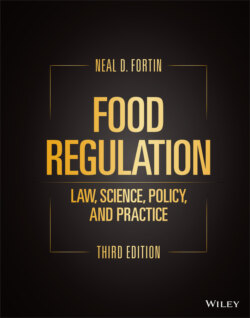Читать книгу Food Regulation - Neal D. Fortin - Страница 19
NOTE
Оглавление1 1.1 Jamaican Ginger Paralysis. “Jake Leg Blues,” “Jake Walk Papa,” other songs from 1929 and the early 1930s lamented paralysis caused by drinking Jamaican ginger extract, commonly called “Jake.” The ginger extract typically contained 70–80 percent alcohol, and during Prohibition, some imbibed it for the alcohol. The extract avoided the alcohol prohibition by being sold as medicine. Jake Leg, a paralytic illness, was caused by intentional adulteration with tri‐orthocresyl phosphate (TOCP), added to avoid prohibition detection while producing a more palatable alcoholic beverage. However, TOCP is a slow‐acting neurotoxin. Over 1930 and 1931, this disease affected tens of thousands of Americans with estimates as high as 100,000. In 1930, the paralytic illness was traced to a single company, Boston‐Hub Products. No law required ensuring the safety of ingredients, so the company had violated no law by adding a poisonous substance. Ultimately, Hub president, Harry Gross, and his brother‐in‐law and part owner, Max Reisman, were charged with violations of the Prohibition Act and for selling “Ginger Extract USP” that differed from the USP standard. Each was fined $1,000 and given a two‐year suspended prison sentence. Jake Leg was caused by a single company, but due to the scandal, the many companies that sold ginger extract saw their market collapse and disappear. John Parascandola, The Public Health Service and Jamaica Ginger Paralysis in the 1930s, 110 PHS CHRON., No. 3, 361–63 (May–June 1995).
The food laws continued to evolve based on the concerns and issues of the times. In the 1950s, concerns over synthetic food additives, pesticides, and cancer were high. Consequently, in 1958, the Food Additives Amendment to the FD&C Act was enacted, requiring the evaluation of food additives to establish safety. The Delaney Clause forbade the use of any food additive that was found to cause cancer in humans or animals. In 1960, the Color Additive Amendment to the FD&C Act was enacted, which required manufacturers to establish the safety of color additives in foods, drugs, and cosmetics.
After a number of well‐publicized outbreaks of botulism food poisoning from canned foods, the FDA issued Low‐Acid Food Processing Regulations in 1973. After deaths from cyanide placed in Tylenol capsules, FDA issued the Tamper‐Resistant Packaging Regulations in 1982. In 1983, Congress passed the Federal Anti‐Tampering Act, which makes it a federal crime to tamper with packaged consumer products.
Throughout the 1980s, there was a growing interest in the effect of nutrition on health along with increased marketing of foods to fulfill health concerns. At the same time, food processing continued a trend toward becoming nationally distributed rather than local. Various states implemented nonuniform laws to regulate health and nutrition claims, which the national industry found hindered interstate commerce. In 1990, Congress enacted the Nutritional Labeling and Education Act (NLEA), which requires nearly all packaged foods to bear nutritional labeling. The act also requires nutritional and health claims for foods to be consistent with terms defined by the FDA.
Then, impetus grew for enhanced food safety regulation over several years of high‐profile food recalls, foodborne illness outbreaks, and consumer advisories. In 2006, fresh spinach sickened over 200, and the fresh greens industry suffered huge losses. In 2007, nearly 2,000 pet food products were recalled due to melamine adulteration of gluten. In 2007, more than 600 people became ill from contaminated peanut butter. In 2008, imported peppers sickened over 1,400, but not before tomatoes were misidentified, causing huge losses to the tomato industry. In 2009—in what may have been the precipitating event—nine deaths and hundreds of illnesses were traced back to peanut paste from the Peanut Corporation of America. In the end, nearly 4,000 consumer products were recalled with an unusually long recall span of over a year. Finally, in 2010, nearly 2,000 cases of illness were linked to eggs from two farms in Iowa, and more than 500 million eggs were recalled.
On January 4, 2011, President Barack Obama signed the FDA Food Safety Modernization Act (FSMA) into law.15 This amendment of the Federal FD&C Act is the most significant revision of U.S. food law since 1938 when the FD&C Act replaced the Food and Drug Act of 1906. The law is historic both in breadth and depth of its coverage.
With this background history, it is time to review some aspects of the U.S. legal system.
